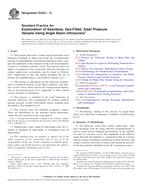Potřebujeme váš souhlas k využití jednotlivých dat, aby se vám mimo jiné mohly ukazovat informace týkající se vašich zájmů. Souhlas udělíte kliknutím na tlačítko „OK“.
ASTM F1512-94(2011)
Standard Practice for Ultrasonic C-Scan Bond Evaluation of Sputtering Target-Backing Plate Assemblies (Withdrawn 2020)
Automaticky přeložený název:
Standardní praktiky pro ultrazvukové C-Scan Bond hodnocení rozprašovací, opěrnou desku shromáždění
NORMA vydána dne 1.6.2011
Informace o normě:
Označení normy: ASTM F1512-94(2011)
Poznámka: NEPLATNÁ
Datum vydání normy: 1.6.2011
Kód zboží: NS-50588
Počet stran: 5
Přibližná hmotnost: 15 g (0.03 liber)
Země: Americká technická norma
Kategorie: Technické normy ASTM
Kategorie - podobné normy:
Anotace textu normy ASTM F1512-94(2011) :
Keywords:
backing plates, bonding, nondestructive testing, sputtering, targets, thin films, ultrasonic testing, Backing plates, Bonding--electronic materials, Electronic thin-film applications, Nondestructive evaluation (NDE)--electronic applications, Sputtering process/targets, Targets, Thin film applications, Ultrasonic testing, ICS Number Code 19.100 (Non-destructive testing)
Doplňující informace
| Significance and Use | ||||||||||
|
This practice supplements Practice E1001 by indicating specific equipment choices and test arrangements appropriate for evaluating sputtering target bonds. The bond between sputtering target and its supporting backing plate is a critical reliability element in a sputter deposition system. A bond must have high thermal conductivity to provide adequate target cooling during sputtering. The target-backing plate joint must also have strength enough to withstand the shear stresses caused by differential thermal expansion between target and backing plate. Flaws in a bond, for example, voids in the joining material, degrade bond performance. An inadequate bond may fail in service, potentially causing catastrophic separation of the target from the backing plate. Assurance of sound bonds is an important concern among users of sputtering equipment. Ultrasonic testing is accepted as an efficient method for evaluating target bonds, but differences in technique inhibit intercomparison of results from one laboratory to another. This practice is intended to promote uniformity in use so that specifications for bond integrity may be universally applied. The C-span display of ultrasonic test data is a direct method for visually demonstrating bond character. Practice E1001 upon which this practice is modeled, however, does not address C-scan display. Instructions specific to the C-scan display mode are indicated in this practice. In other respects this practice is a section by section commentary on Practice E1001. |
||||||||||
| 1. Scope | ||||||||||
|
1.1 This practice describes a method for ultrasonic mapping of the soundness of a bond joining a sputtering target to its supporting backing plate. The results of the examination may be used in predicting the target-backing plate assembly's suitability for use. Accept/reject standards are not specified; these are subject to agreement between target supplier and user, depending upon the application requirements. 1.2 This standard is intended to be used with Practice E1001. 1.3 The method reveals unbonded areas 0.125 in. (3 mm) in diameter and larger. The technique permits, for example, unambiguous quantitative measurement of the voided area in solder bonds. 1.3.1 This technique may also show regions in which bond integrity is marginally degraded by imperfect adhesion, for example, areas in which oxide inclusion has inhibited the development of full bond strength. Evaluation of indications of degraded bond areas may vary in rigor from purely subjective to semiquantitative. Target supplier and user must agree upon the means used to display and grade partially bonded areas. 1.4 This practice is applicable to assemblies having planar bonds in which the design provides at least one flat plane parallel to the bond that may be used as the entry/exit surface for ultrasonic excitation. 1.5 Only the immersion pulse-echo method is covered. 1.6 Evaluation by this method is intended to be nondestructive. For target assemblies that would be degraded by immersion in demineralized water, for example, for porous target materials, the test should be considered a destructive one. 1.7 This practice is applicable to bonding methods that use a filler material to join the target and backing plate. These include solder, epoxy, and braze bonds. 1.8 The values stated in inch-pound units are to be regarded as standard. The values given in parentheses are mathematical conversions to SI units that are provided for information only and are not considered standard. 1.9 This standard does not purport to address all of the safety concerns, if any, associated with its use. It is the responsibility of the user of this standard to establish appropriate safety and health practices and determine the applicability of regulatory limitations prior to use. |
||||||||||
| 2. Referenced Documents | ||||||||||
|
Podobné normy:
Historická
1.7.2011
Historická
1.6.2010
Historická
1.6.2010
Historická
1.6.2013
Historická
1.6.2013
Historická
1.6.2010



 ASTM E2024/E2024M-11..
ASTM E2024/E2024M-11.. ASTM E2075/E2075M-10..
ASTM E2075/E2075M-10.. ASTM E2076/E2076M-10..
ASTM E2076/E2076M-10.. ASTM E2192-13
ASTM E2192-13 ASTM E2223-13
ASTM E2223-13 ASTM E242-01(2010)..
ASTM E242-01(2010)..
 Cookies
Cookies
